 Only known photograph of Antarctica's most wanted man, ice-terrorist Ali Fatah Morgana
Only known photograph of Antarctica's most wanted man, ice-terrorist Ali Fatah Morgana
Originally the diary of 4 months spent in Antarctica working as a documentary film sound recordist, this blog has evolved into an online repository for the thoughts, travels and trivia of the writer Richard Fleming. For McMurdo Station, Antarctica, and polar exploration, see August through December of '06. Currently you are likely to find in these pages chronicles of my actual and literary meanderings, as well as notes on my many other passions. Also, did I mention I wrote a book?
9/30/2006
9/29/2006
Morgan le Fay
We made an abortive attempt to drive out to Cape Evans across the sea ice yesterday. All morning the sun shone, and visibility was unlimited, but soon after we had loaded up the Pisten Bully and set off ominous clouds appeared to the south-east, and it wasn't long before the firehouse radioed us. They had recieved a call from Mac weather; with their profuse apologies came the order to return at once. Thankfully we were out long enough to see this mirage, a spectacular fata morgana.


Happy Birthday, Luke!
My beloved brother is living with some pre-Columbian Brazilians and learning to speak Tucano somewhere in the farthest upper reaches of the Rio Negro, near Brazil's border with Colombia, so it was a sort of miracle of telecommunications that I was actually able to speak to him in person all the way from McMurdo and wish him a happy birthday.
We're thinking of you and toasting your adventures!
 I'm the good looking one.
I'm the good looking one.
We're thinking of you and toasting your adventures!
 I'm the good looking one.
I'm the good looking one.
9/28/2006
Teatro del Absurdo in two acts
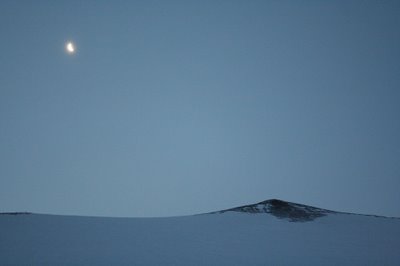
The solar tide is turning. We arrived in midday twilight; now, just more than a month later, it is nine or even ten o'clock at night before it gets as dark. This means of course, in the way that these things inevitably go on film shoots, that only days ago we realized that our film was dreadfully lacking in all things nocturnal. So we have rushed into night mode, staying up later and later to film in an ever-narrower midnight patch of obscurity.
Last night we ventured out to the ice runway, where the night shift of snow-blowers and bulldozers was toiling away to open the apron. Here the first flight, on October 3rd, will disgorge its fresh Antarctic passengers, refuel, and then turn and taxi before taking off to fly back to Christchurch. One can only hope that it will also unload many fresh vegetables.
We parked on the runway, facing south in the dim blue gloom. Across the plowed and blown ice before us, captured in the headlights, was an unbroken white sheet of drifting snow in constant motion, flowing along the surface, so that we appeared to be a ship moored in a wide river of translucent, rippling milk. To our left over the darkness of the apron roamed a dozen enormous Caterpillar tractors, dozers and snowblowers, like gigantic aimless lightning bugs. Entirely invisible save for their massive headlights, they crossed back and forth in a circular choreography of diesel testosterone. Endlessly they pushed the snow from one place to another, an absurd Sisyphean ballet about waiting for the next storm to bring more labor.
Tonite we sought the diesel-free wilderness, venturing out along the permanent ice shelf, where Ross Island meets that part of its sea that has remained unthawed for thousands of years. I had, for the first time, the opportunity to record silence, a topic that has been of some debate between Anne and myself. (I am a sound recordist, I told her, not a silence recordist). And so, with the pots controlling my stereo microphone turned all the way up, standing still as a stone, the mic pointed over the white void towards the south pole, I recorded. Nothingness. Not a light glimmering on the meters. My stomach gurgled and I wondered if I had heard the sound through the headphones or internally, within my body. Far away the ice creaked, but not even this registered the merest blip on the digital meters of the portable mixer I use.
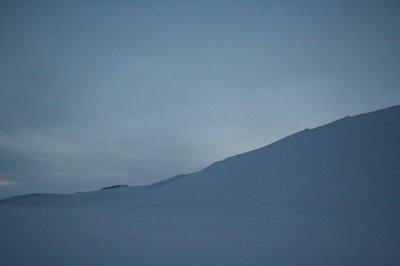
Because we have had occasion to film once or twice a solitary soul wandering off across the ice, on a voyage of discovery or lost in an existential crisis, and because filming such wanderings requires the three of us, plus the subject, to crunch along like a herd of elephants marching across a field of styrofoam peanut packing foam, thereby rendering the synchronous sound unusable, we decided to take advantage of the silence to record isolated footsteps in the snow, in the hopes that they might help the editor later. I directed Sylvestre to walk purposefully towards a particularly perilous crevasse, and captured his crunchy stride for all eternity. There at the edge of the ice-shelf in the dim silent night, beneath a quarter of a moon, the three of us marched about, with no destination in mind, making crispy footfalls that echoed off the hillside behind us. Finally I burst out laughing. It was beyond surreal. "This is better than Beckett!" I shouted.

9/25/2006
Reading: The Antarctic Diaries of Edward Wilson
 Photo: M. Deany
Photo: M. DeanyYesterday Deany and I went skiing on the Castle Rock trail. As was the case when Anne and I hiked up there a couple of weeks ago, we were met at the trailhead by a vicious headwind. It was full-on balaclava and goggles weather, with each of us peering into the face of the other to look for any slivers of exposed skin before setting out; frostbite was a real possibility. Neither of us said anything to the other until much later down the trail, but it turns out that as we were bundling up to get started we were both thinking "damn, what a stupid idea this is." As is usual with such ventures persistence is rewarded, and by the time we reached the first tomato (the emergency shelter) the wind was already slackening. It was blissful and quiet, with only the slide of the skis and the crunch of the poles audible in the air. The snow was hard and brittle so we weren't exactly kicking and gliding, but the skis beat trudging along on foot. Beyond Castle Rock conditions were much calmer, and we shushed our way down the side of the mountain with only a handful of spectacular and catastrophic spastic collapses between us. Tumbling on cross country skis down an icy hillside has the graceless, unnaturally angular quality of a shot heron falling out of the sky and plummeting to the ground. Deany managed to shatter one of his bamboo ski poles and had to finish out the trek using a bamboo flag as a replacement. This flapped over our heads all the way home, as if we were a very small parade.
 It's a long walk for one run, but how many people have snowboarded from Castle Rock down to "the Great Ice Barrier"? Martin, thrashing.
It's a long walk for one run, but how many people have snowboarded from Castle Rock down to "the Great Ice Barrier"? Martin, thrashing.The turn out of the steep slope down to the west of the rock opened the door to an immense vista of sea ice stretching endlessly to the south, towards the Pole. Here before us, had we stood on this spot some 104 years ago, on November 2nd, with binoculars, we might have seen Scott's party setting out on the "Southern Journey," of 1902. Accompanied by E. A. Wilson, biologist, artist and expedition doctor, and Wilson's close friend Lieutenant Ernest Shackleton, Scott aimed to reach farther south into the continent than any preceding expedition. Within days, in fact, they had pushed beyond the mark set by Carsten Borchgrevink some years earlier.
Wilson's diaries
 Erebus, smoking
Erebus, smokingAs Deany and I could see when looking out from the slope behind Castle Rock, the southern journeymen had not even the prospect of encountering land to sustain them in their long uncomfortable slog towards the Pole. The icy winter slip for the ship Discovery, here at McMurdo, and the establishment of McMurdo as the US Antarctic Program base in the 1950s are both thanks to our being on the dividing line between the seasonal sea ice and the permanent ice shelf, which Scott's party referred to as "the Great Barrier." Immediately off the point, in front of the collection of pale green outbuildings that make up New Zealand's Scott Base, just a kilometer or so from our office as the skua flies, immense undulations of buckling ice mark the line. From the foothills of Erebus, where Deany and I were skiing, no land relieves the endless view across the permanent ice shelf to the south. Scott, Shackleton and Wilson sledged this way, butchering their weakest dogs to feed those that continued to pull weight. (It is notable that two of the major criticisms which continue to be used to diminish the accomplishment of Amundsen's stroll to the Pole are that he savagely killed his dogs off along the way and that he was single-mindedly focussed only on reaching that elusive spot on the end of the earth, to the exclusion of all science. Nothing in Wilson's account suggests that much about Scott's approach differed. In fact, the "failure" of Scott's dogs appears to have much to do with their being almost grotesquely overburdened, in contrast to Amundsen's.)
For sixty days the trio marched southwards, managing very little mileage, as the dogs could not cope with the overloaded sledges. The party ended up dividing the cargo, making two trips each day to move it all, walking three miles distance to cover each mile south, like a terrible and endless series of canoe portages. Eventually they did sight land, and even got close enough at the very end of the journey to some cliffs, from which they hoped to secure geologic samples of the rock. This proved impossible because of an enormous ice cliff, and finally, on New Year's Day, they turned back. We might describe them as returning empty-handed, but they were by now pulling their own sledges, and faced a full month of snow-blind twenty-four hour graylight ice-shelf trekking misery before they would stumble back into camp. Wilson's account of how he spent my birthday in 1903 is typical: "Turned out at 6AM to another hopelessly overcast day, with nothing to steer by or fix one's light-dazzled eyes on. After an hour's marching we found the steering so erratic that we camped and waited to see if it would clear. At 4PM there was enough break in the cloud ahead to steer by, so we had another breakfast and at 6PM started off again. We did nearly three hours and then camped as Shackle was feeling bad. Now it is nearly midnight and we have turned in. Outside one can see nothing at all, either in the sky or below it, all one uniform brilliant gray light without a break. One cannot see one's own footsteps in soft snow in this light, nor any of the inequalities that one stumbles over.... My eyes today have been very weak and painful."
What a contrast with our day yesterday staring out over the ice shelf from the hills of Ross Island! As we skied down the slope of Erebus onto the sea at the edge of the great barrier, we had brilliant blue sky overhead. Scarcely a breath of wind rustled the bamboo flags, and the snow was packed so solid that the edges of the skis left little trace. Deany and I peeled off our balaclavas, opened the vents on our technical parkas, and whizzed along, getting long smooth glides out of each ski-step. In the crisp subzero snow-pack each thrust of a ski-pole made a sound like the cry of a distant tern fishing over the ocean. "Man," said Deany, "we're skiing, in Antarctica!" At Scott base, the circuit complete, we unbound our skis and set off walking across the hill to McMurdo, warm and energized and looking forward to a good cup of tea.
 "A nice cuppa Jasmine Green?" Photo: M. Deany
"A nice cuppa Jasmine Green?" Photo: M. Deany
9/24/2006
Angela, you look hungry
9/23/2006
Just another day on the sea ice

Asked to discuss his sublime photographs
We drilled holes to test the thickness of the ice, and filmed others drilling holes. We passed Inaccessible Island, too steep for the great explorers to have landed on; nobody else seems to have made so much as a mark since.
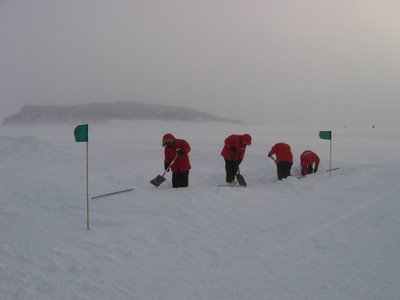
 Those little black spots under the Barne Glacier are big fat Weddell seals
Those little black spots under the Barne Glacier are big fat Weddell sealsAt the foot of the Barne Glacier a collection of enormous brown tubular sausages lounging on the ice constituted our first sighting of Weddell's Seal. Vast torpedoes of blubber, they rolled in the snow, occasionally lifting a languid flipper or a wedge-shaped tail. Years of birdwatching have taught me that committed efforts to watch wildlife always lead to the most spectacular natural settings on earth. Of all the places to choose, the seals were resting directly beneath the unearthly crystal-blue ice-cliffs of the Glacier. Science says they are there because the pressure cracks in the sea ice that radiate out from the glacier towards the outlying islands create access holes where it easy to pass from the water to the surface, but they seemed to me to have chosen the spot for its awesome surroundings.

Nonetheless the Barne Glacier has undoubtedly moved, travelled, broken, warped and calved far too much over the last eternity of millennia for the view to have been of any use to Sugimoto. Instead it was to the west, over an unbroken and untraveled sheet of sea-ice, that the vista, of only the narrowest slit of sunlit mountains, trapped between ice and low white sky, spoke of the infinite.

9/21/2006
Do you have any Dr. Pepper?
The storm has passed on in the night and as Sylvestre put it, "today we are making a documentary about shoveling." We've been here just over a month now and virtually all of the 397 people currently on station are aware that a documentary film crew is in their midst. People we haven't even met approach us in the hall by the coat racks or come up to us at dinner and give us hot tips. Last night a thoughtful guy named Lenny, from building 159, which houses all the support for airplane repair, stopped by our table to let us know that 159 was snowed in in a pretty serious way and that their department would soon be getting involved in some profound snow-moving operations. After he left Anne said, "look, now people are doing our location scouting for us." We went down there this morning and found that their front door was completely drifted in, save for a forearm sized patch of sky visible at the top left of the door. Because their door opens inwards they had already converted this wall of snow into the world's smallest refrigerator by carving out one rectangular Diet Pepsi-sized niche. As if one needs a refrigerator here for anything other than to stop things from freezing....

The rectangle bang in the middle of the doorway fits exactly one can of soda.
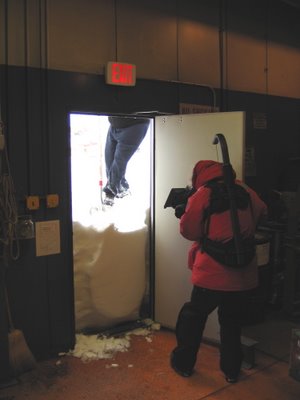
Sylvestre films the half-demolished fridge.

The rectangle bang in the middle of the doorway fits exactly one can of soda.

Sylvestre films the half-demolished fridge.
9/20/2006
Hokusai out the window Dept.
For the last thirty hours or so we have been hearing almost constantly that "they" are about to declare Condition One. During most of this time the weather state has officially remained at Condition Two, but the snow and wind is so thick that it is already quite exciting to walk the fifty yards from Crary Lab to the Galley, so the conversation about when the downgrade to Condition One will occur has become a constant. We discuss having pajama parties in Crary Lab and busting out our "sleep kits" and setting them up on the sofas upstairs and then realize it is still Condition Two and hurry off to eat something in the cafeteria.
Three Views out the office window
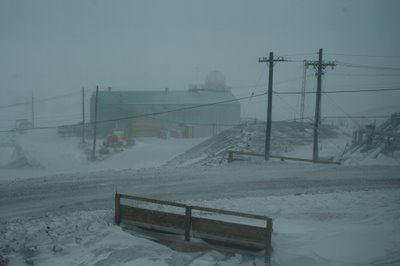 View of probable Condition Three
View of probable Condition Three
 Unequivocal Condition Two
Unequivocal Condition Two
 Possible Condition One
Possible Condition One
In other news antarcticiana always stands by its story; you will find no retractions here. However, I did receive an email informing me that it was irresponsible to have recently posted something to the effect that I could hardly wait to drive my own Pisten Bully out onto the ice and turn it off and lie on my back in blissful silence. The assiduous reader of this blog will already have picked up on the subtle yet persistent theme of the annoyance of idling engines, particularly as they impact my task of recording useable film sound. One can only hope that this thread, running as it does through various entries, has been appreciated for its humourous character. Just in case it has not, let me emphasize that I am in fact well aware that driving a motorized vehicle out into the middle of a frozen sea in subzero temperatures and turning it off in order to "let the engine cool down" or "record seagulls" is a recipe for, at the very best, a long and chilly afternoon spent waiting to be rescued by a posse of diesel mechanics. I am a wuss who is among other things almost pathologically uninterested in polar swimming, so rest assured that anything you have read to the contrary is, as they say, what passes for humour around here.
Three Views out the office window
 View of probable Condition Three
View of probable Condition Three Unequivocal Condition Two
Unequivocal Condition Two Possible Condition One
Possible Condition OneIn other news antarcticiana always stands by its story; you will find no retractions here. However, I did receive an email informing me that it was irresponsible to have recently posted something to the effect that I could hardly wait to drive my own Pisten Bully out onto the ice and turn it off and lie on my back in blissful silence. The assiduous reader of this blog will already have picked up on the subtle yet persistent theme of the annoyance of idling engines, particularly as they impact my task of recording useable film sound. One can only hope that this thread, running as it does through various entries, has been appreciated for its humourous character. Just in case it has not, let me emphasize that I am in fact well aware that driving a motorized vehicle out into the middle of a frozen sea in subzero temperatures and turning it off in order to "let the engine cool down" or "record seagulls" is a recipe for, at the very best, a long and chilly afternoon spent waiting to be rescued by a posse of diesel mechanics. I am a wuss who is among other things almost pathologically uninterested in polar swimming, so rest assured that anything you have read to the contrary is, as they say, what passes for humour around here.
9/19/2006
Snow Day
The bottom of a glass of milk

At 8:07 this morning I was still in bed in my minuscule half of a dorm room. Around here that constitutes sleeping in, but we had scheduled a bunch more sit down interviews for today and the first one wasn't to be until around ten. I woke when the phone started ringing, an occasion so rare that I didn't even know the room had a phone in it until a few days ago. "The weather has shifted, plans have changed we're going out on the sea ice, and we have to be ready in twenty-five minutes." Anne, on the phone. "That's going to be hard," I said. "Goodbye." I managed to go from boxer shorts in bed to seven full layers of ECW (that's extreme cold weather to you, you indian summerer) in the office in about twelve minutes, but I wasn't very happy about it. We grabbed more bags of ECW gear, sound gear, camera, tripod, E Z rig, thermoses of hot liquids, water bottles, snacks, bag lunches, ice drills and bamboo flags and loaded up Pisten Bullies 313 and 315. The whole time I was thinking: this is a rude awakening.
 In memory of Clyfford Still
In memory of Clyfford StillIt turned out to be an inauspicious start to a glorious day. I don't want to badmouth McMurdo too much, but it was just wonderful to get out of town again. The three of us, along with Cece and Thai, who also took us camping at forty below, and Dr. Regina Eisert, our local seal scientist, headed out to examine the route over the ice to Regina's future camp, where she will take endless blood and milk samples from calving Weddell seals in what passes for the summer around here.
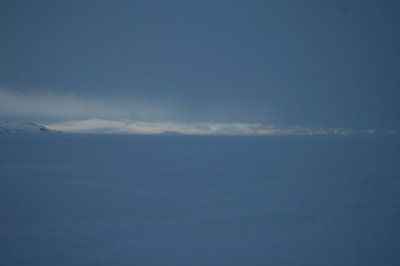
A storm was threatening and the sky was low and uniformly gray, but visibility was good and we could see a band of sunny mountains along the horizon line, a sliver trapped between blank white sea ice and cold gray sky. From time to time the wind came up and the view deteriorated. In the blowing snow there was no separation between sky, ground, air, or even windshield. Thai described this condition as "driving around the bottom of a glass of milk," or "being inside the ping pong ball." From time to time we stopped and drilled and flagged, leaving a trail of flapping banners on bamboo stakes to mark the route.
 Two big Bull inna one pen
Two big Bull inna one penFollowing a pressure fault in the ice, we looked for a place to pass over the crack. By drilling a series of holes and measuring the depth of the ice Cece and Thai determined not only that we could not cross, but that a Pisten Bully would quite likely plunge through into the Ross Sea; in places there was less than a meter of ice, and at one point my foot went through a shell of snow down to my thigh before my foot came to rest on the thinner layer of ice covering the crack. Seal scat and blood on the snow indicated the presence of seals, and the presence of holes through into the water below, but with the water temperature a balmy negative one or two C Regina said she was sure that the beasts would stay under the ice, and indeed we didn't see any.
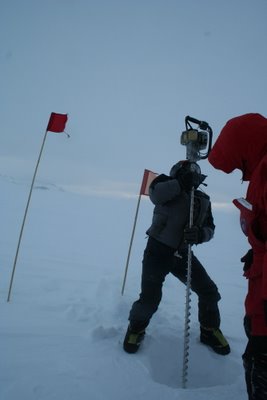 "Screw you, buddy." Cece performs an extraction--that's three meters of ice probe, son
"Screw you, buddy." Cece performs an extraction--that's three meters of ice probe, sonWe drove on and soon found a bridge, where another long series of bored holes showed the ice to be at least two meters thick. After drilling a few holes I lay on my back on the ice and looked up into the massive ceiling of clouds and felt a kind of euphoria. Anne and Sylvestre were filming some distant landscapes from the wind-shelter of the Pisten Bully. Since Cece refused to let us turn the vehicles off in case they wouldn't start again I elected once again not to record the sound of the engines as the soundtrack for the spectacular mountain scenery and instead just lay on the ice feeling wonderful and watching snow blow past. I don't know why I was enjoying myself so much but something was going on and I was blissfully content.
 The black spots are Cece and Thai, drilling in the void
The black spots are Cece and Thai, drilling in the voidTomorrow we are going out again for our official "sea-ice training" and I was so happy out there that I was tempted to ask them just to leave me out there until then. Once we have completed our sea-ice course we will be able to drive out onto the sea ice ourselves and take our chances turning off our own damn Pisten Bully. Of course then I'll actually have to work and not lie around like a seal.
 The rear view mirror inside the ping-pong ball, and a bamboo flag floating in a bowl of milk...
The rear view mirror inside the ping-pong ball, and a bamboo flag floating in a bowl of milk...
9/17/2006
9/16/2006
The brilliance of the Finns

We took today off after filming ten interviews yesterday in our "interrogation room." At this point, on a free day, I am all for seizing every opportunity to get out of McMurdo. Anne agreed, and joined me on a hike to Castle Rock, one of the few trails currently open for recreational walking, two people minimum. Upon checking out with the firehouse they informed us that the weather was looking ominous and recommended that rather than do the entire seven-mile loop we ought rather to turn back at the rock and make it a shorter round trip. It was clear and bright and cold and windy and when we reached the top of the road that climbs up behind the "Heavy Shop" something that looked rather like a potential storm was sitting out on the horizon, and we suddenly had at least thirty knots of wind right in our faces. It was pretty slow going, uphill and into the headwind, and there were moments when we were setting our goals pretty low, as in trying to get up the enthusiasm to reach the next bamboo flag, twenty yards further. Finally we reached the first survival hut, called the Apple, or the Tomato, and tucked inside to break out our thermos and have a cup of tea. The Apple has two cots with frost encrusted sleeping bags, a cook stove, a medical kit, emergency food, and a fold out table for pouring the tea.

Our friend Mike the rigger and his girlfriend were once caught in a vicious storm and had to spend the night in the predecessor to the Apple; even though it is only a couple of miles back to McMurdo if the weather gets nasty and visibility goes to nothing it sometimes does happen that it is better to just sit tight out there.
We returned via the Hut Ridge Loop trail, which I hiked last weekend with Deany. It was completely different today than last time, when it was overcast and blowing snow. Today the wind threatened to push us off the ridge and down onto the frozen sea far below, but we were in bright sunshine and it was a spectacular walk down to the "Discovery" hut.


Back in time for a hot lunch I took further advantage of the posh comforts that you dwellers of the milder latitudes can't possibly imagine we have down here. I went to building 209 and had a sauna
Subscribe to:
Posts (Atom)
















